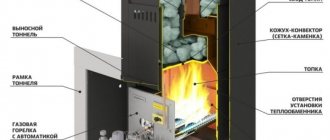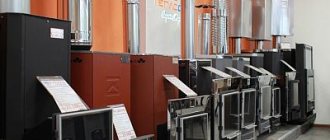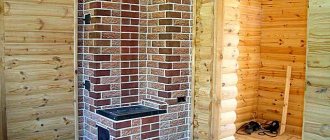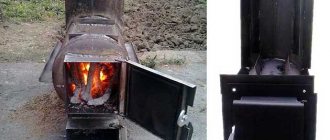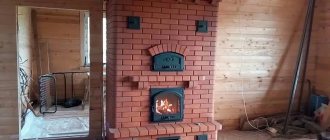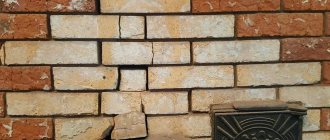When talking about repairing sauna stoves, we most often mean brick devices. As you know, their laying requires special knowledge and experience. If the work was carried out by a qualified stove-maker, the structure will last for decades. However, nothing on earth lasts forever, therefore, sooner or later, any sauna stove begins to require repair. It’s quite expensive to call a stove repairman every time, which means you need to learn how to fix some problems yourself.
Solutions for caulking stoves in a bathhouse
Personally, I have a brick heater in my bathhouse, which I don’t regret at all.
But I know very well such problems as cracks and crumbling plaster. A massive stone stove is sometimes quite finicky and requires some trouble and periodic repairs. But true lovers of bath science know that the heat from a stone stove is incomparable to anything.
Everything has its own lifespan, there is no exception. Stones laid in a heater and even the brickwork itself, when exposed to very strong heat and humidity, lose their properties over time.
This is immediately noticeable in those places where there is very strong heating along the walls, near the furnace door. Here the putty crumbles and cracks appear on the stove very quickly.
Brick stove repair
When laying a heater, a solution of clay and sand is used. This putty solution can withstand temperatures up to 1000 degrees Celsius.
Clay for repair work needs a special, plastic one. The fatter the clay, the more sand is added.
The stove itself is also plastered with the same putty. It is important that the clay is of very good quality; it should not contain small pebbles or plant roots. The same goes for sand, it needs to be sifted.
But even observing these requirements, it is impossible to ensure that cracks do not form and the masonry does not crumble. Consequently, you will have to constantly repair the stove in the bathhouse, and you won’t have to forget the putty solutions for a long time.
Now I'm on the verge of using another recipe for oven caulk. I accidentally found it in an ancient stove maker's book. To prepare the putty you need:
- Take equal amounts of wood ash and dry, powdered clay.
- Add 1/4 part salt
- Add water to knead the dough
The density of the resulting solution can be adjusted independently. The less water you add, the thicker the solution will be.
Under the influence of high temperature during combustion, this putty quickly hardens and does not fall off for a long time. This solution recipe is unusual in that it does not use sand.
Don't be afraid that when it dries, the color of the putty will be very dark. Salt contains so many secrets! You will see how the salt crystals will sparkle. Very unusual! Of course, if you are not satisfied with the resulting color scheme, you can whitewash the stove without any problems.
I really hope that your stove will not lose its beauty for a long time. With this recipe for oven caulking solution, you will be freed from unnecessary worries and frequent repairs.
Other reasons
There are other reasons why cravings disappear and the stove in the bathhouse begins to smoke intensely. In such a situation, not only internal factors are at work - design errors, clogging, but also external ones:
- wind – strong gusts of wind lead to smoke being thrown into the oven; having lost the ability to move upward, the smoke goes into the room, this problem is easily solved by the installation of chimneys or weather vanes, the devices prevent the ingress of water and snow;
- high humidity - at the same time the atmospheric pressure decreases, and the smoke becomes denser, it moves very reluctantly, this phenomenon can be seen during fog: the smoke spreads along the roof and returns back at the slightest gust of wind;
- the hotter the sun shines, the worse the draft; the temperature difference between the smoke in the chimney and the air outside is too small to create draft, and at temperatures above 35 degrees, capsizing occurs.
Sometimes, to prevent smoke, you just need to light the stove correctly.
How and with what to repair a hole in a metal stove if it is rusty?
At the junction with the pipe, the stove has rusted to a hole in places. Previously, it flowed through the pipe, so water accumulated. Is there any way to plug the hole?
If yes, then how and with what?
comment to favorites up —> Gurus tarr [64.4K] over a year ago
Welding will not work, since the metal has become thinner and there will be nothing to grab onto. After the first firing, asbestos (not only does it stink) will disintegrate into pieces and turn into powder. You can actually seal it with clay and sand. But you need to know the ratios for ceramics or bricks. Otherwise it will crack and fall off. To be sure, this clay bandage should be placed in a kind of metal clamp, which should be slightly larger than the diameter of the pipe. Estimated to be 2 centimeters around the pipe and the same in height. Clay can be replaced with a mixture of slaked lime, ash from the same stove, gypsum or cement and asbestos filler. I usually putty on the slab with it - it holds it tightly.
the author of the question chose this answer as the best comment add to favorites link thank sprin g9483 74 [332K] 9 months ago
The stove is already old, the metal is delaminating not only in the area where the pipe is connected. The best solution here would, of course, be to completely replace the stove with a new one. But it’s really good to change it along with the country house) As a temporary measure, the hole can be covered, for example, with thicker clay. You can also take a strip of tin, bend the strip in the middle lengthwise by 90 degrees, make cuts on both sides of the bend and wrap this tin strip around the place where the pipe is attached. You can secure the patch with wire, tying it around the pipe. The hole was closed - sparks would definitely not fly into the house. And - choose a new stove!
comment to favorites link thank STELS [242K] 9 months ago
This is a potential fire source! In my opinion, only a major overhaul!
But the question must be answered.
First, eliminate the water leak from the ceiling through the pipe (apparently, not all is well with the waterproofing of the roof and ceiling)
Now let's start the renovation. In my mind, it’s better to replace the pipe altogether, and the stove itself - you can see from the photo that everything is rubbish (again, I’m taking a radical approach, and for good reason!)
But if you really want to leave it as it is (even despite the rather serious fire hazard of such a state) and at the same time you don’t have a guy with hands growing from your head and a welding machine nearby, then stock up on dry welding, strip the pipe and furnace down to “living” metal, degrease, and apply a thick, thick tourniquet of this welding (it will take more than one tube, and not even five - more) And all this is done on a cold stove.
After this, wrap the sheet around the pipe itself, overlapping (overlapping the sides of the sheet) the vertical seam by at least 1/2 of the diameter of the pipe, with a widening socket to the surface of the plate (covering the welding putty) and secure with clamps along the entire length of the pipe.
To prevent the cast iron stove from cracking
Another common problem with using brick stoves, not purely bath stoves, but heating and cooking stoves, is cracks in the cast iron stove. They are not terrible if the stove is made correctly, but if there are errors in the masonry or design, smoke and carbon monoxide can leak through the crack, which is many times worse.
In principle, a well-cast slab made of high-quality cast iron should not crack, but the trouble is that such things are very rare. However, trouble can be helped. When firing for the first time, you need to slowly heat the stove, avoiding local overheating, and cool it down just as slowly. This can be done by laying bricks on the surface of the cast iron or pouring a good layer of sand. Remove the brick and sand after the stove and stove have cooled completely. These materials distribute heat without allowing large temperature fluctuations, and therefore cracks. Also, a uniformly loaded hob will sit smoothly, without distortions, which can also cause stress and cracks.
The sauna stove burned out, but the owner didn’t even know about it and continued to use it
The customer called me and said - I urgently need to replace the stove, it burned out. I asked him what model of the stove, to which he replied that he took it from a neighbor 6 years ago and did not know what model it was. We agreed to meet at the site.
I arrive and see that the stove is factory-made, “Breneran”
The shape of the stove is not ordinary; there is an ash on the door, which regulates combustion, and there is also an ash drawer, which can also be used to increase draft.
I look into the firebox, and all the walls there are leaking, this is the first sign that the stove will soon burn out.
The stove burned out at the top of the stove.
This model has a cleaning hole near the chimney outlet, which is closed with a small lid.
The most unpleasant thing in this situation is that the owner did not even suspect that the stove had burned out, he just wanted to move the stones, when he started sorting them out, then he saw that the stove had long since come to an end.
Moreover, no burning was felt in the steam room.
Why did it happen? I think that the owner overheated the stove and did nothing to regulate the draft. There is no damper, they didn’t immediately tell him that a damper was needed and that under no circumstances should he fire the stove “crazy”.
Most likely, after 6 years of such operation, the chimney also needs to be changed, especially since it is not of the best quality. The owner of the bathhouse was of course upset, because he wanted to go take a steam bath this coming weekend.
Whose oven burned out and you didn’t find out about it right away? Share your experience in the comments.
Pechka channel subscribe.
The article uses unique copyright content, any copying of part of the text and photographs is only with the permission of the author.
The stove in the bathhouse burned out, how to repair it without welding
You are using an outdated browser. This and other sites may not display correctly. You need to update your browser or try using a different one.
Used for gluing decorative elements made of ceramics, stone or other mineral materials to heated surfaces. Recommended for masonry, cladding, putty, grouting and repairing stoves, boilers, fireplaces and sealing cracks in chimneys. The mastic is resistant to water and temperatures up to +1300°C. Excellent adhesion, high elasticity, ease of use, low consumption.
Two kinds of sealing materials
There are a large number of sealants of various compositions. Only two main groups are resistant to high temperatures:
- organic (silicone) composites based on silicon;
- silicate products.
The first group is called heat-resistant sealants, the second - heat-resistant.
Polymers that have silicon atoms in a linear chain are called organosilicon. The name “polyorganosiloxanes” reflects the structure more accurately. Often such heat-resistant sealants are called silicone rubbers.
Depending on the nature of the vulcanizing additive, the heat-resistant sealant may form acidic or neutral by-products when curing. Additives with an acetoxy group cause the release of acetic acid after polymerization.
This makes it impossible to use them for stoves and fireplaces that contain cement, metal or concrete. The acid causes the formation of oxides, and a layer of salt forms on the surface. As a result, the tightness of the heat-resistant seam will be compromised.
Neutral vulcanizing additives can be used for any sealants. Polymerization of a substance with an alkoxy group is initiated.
As a result, some limiting alcohol is released, which easily evaporates without harming the hardened sealant. The heat-resistant, insulating qualities of the composition are preserved.
The stove in the bathhouse burned out, how to repair it without welding
You are using an outdated browser. This and other sites may not display correctly. You need to update your browser or try using a different one.
Used for gluing decorative elements made of ceramics, stone or other mineral materials to heated surfaces. Recommended for masonry, cladding, putty, grouting and repairing stoves, boilers, fireplaces and sealing cracks in chimneys. The mastic is resistant to water and temperatures up to +1300°C. Excellent adhesion, high elasticity, ease of use, low consumption.
The stove in the bathhouse burned out, how to repair it without welding
You are using an outdated browser. This and other sites may not display correctly. You need to update your browser or try using a different one.
Used for gluing decorative elements made of ceramics, stone or other mineral materials to heated surfaces. Recommended for masonry, cladding, putty, grouting and repairing stoves, boilers, fireplaces and sealing cracks in chimneys. The mastic is resistant to water and temperatures up to +1300°C. Excellent adhesion, high elasticity, ease of use, low consumption.
Metal stoves, do-it-yourself sauna stove repair
In many bathhouses, people began to install metal stoves. This can be explained by the fact that such structures have a high heat capacity and are able to quickly heat a room of any size. If a metal sauna stove breaks down, it is necessary to identify the causes of the breakdown.
Any metal sauna stove has a number of advantages:
- does not crack;
- has a high level of heat resistance;
- heats up quickly;
- has compact dimensions;
- easy to transport;
- quickly installed.
Do-it-yourself brickwork of the stove
Many experts know that for long-term use of a metal stove in a bathhouse, it is best to make brickwork on the outside. In this case, it is advisable to provide masonry made of refractory bricks. It is necessary to provide a gap between the metal stove and the brickwork. This is necessary to prevent the metal from burning through. This air gap should not be too large.
When building a stove in a bathhouse, it is necessary to purchase high-quality sheets of iron. It is best if it is iron 4-5 mm thick. If at the initial stage of building a metal furnace, low-quality iron is purchased, then the furnace can quickly fail. Most often, such stoves lack draft, which makes the steam room poorly heated. If you build a metal stove with your own hands, then you must take into account all fire safety requirements.
Sauna stoves, causes of breakdown
If a metal stove in a bathhouse breaks down, you need to identify the cause of the breakdown. To do this, it is best to use the services of specialists who know the features of this type of structure. After an inspection, a specialist can determine what needs to be purchased and replaced. It is important to remember that any metal sauna stove has a blower, which must be installed correctly. There should be good draft in the blower. Very often the stove does not heat well due to the fact that it is not buried correctly. When installing a metal sauna stove, it is necessary to properly deepen it. It is necessary to provide for strengthening the furnace with steel strips.
A metal stove retains heat quite well. This occurs due to a metal cylinder, which is filled with hot air and holds it for a long time. To identify a malfunction of a metal stove, it is necessary to disassemble the brickwork. If it is discovered that a crack has appeared in the iron, then you need to consult with a specialist to determine whether the iron sheet needs to be changed or whether the crack can be welded using a welding machine. If you need to use welding, then you will additionally need to provide an angle grinder and welding electrodes.
Advantages of metal stoves
Quite often they began to build metal stoves in the bathhouse because they are practical, economical and environmentally friendly. The metal from which the stove is made has a long warranty, which significantly increases its performance characteristics. When installing a metal stove for a bath, you must follow certain rules:
- It is advisable to use a light oven;
- you need to take into account the distance between the iron and the brickwork;
- you need to take into account the height of the stove and the distance to the ceiling.
Naturally, such parameters for the installation of a metal furnace can only be taken into account if you have experience in this area. Today, many construction enthusiasts, before starting to build a bathhouse, try to consult with specialists who can warn them against problems that arise later.
Insulation of the place where the sauna stove is installed
If a metal stove is created in a bathhouse made of wood, it is necessary to provide lining with insulation. Today, the insulation can be made of stainless steel sheet, which will allow the stove to be heated to the maximum temperature. Quite often, in bathhouses, the stove began to be installed in the corner. In this case, it is necessary to provide insulation in the form of a corner sheet of metal, which will allow for quick and high-quality cladding inside the bathhouse. Sometimes stainless steel can be replaced with other finishing materials:
- tile;
- stone;
- porcelain stoneware;
- terracotta;
- clinker;
- tile.
If, while vaping, people notice that the stove does not emit the required temperature, then it needs to be disassembled and the cause of the low temperature is identified. To do this, it is advisable to provide a plan or drawing with which you can quickly disassemble it and find the cause of the breakdown. Having examined various drawings of stoves, you can repair the stove with your own hands.
Very often you can identify the following faults in a metal furnace:
- poor fastening of the steel coupling;
- poorly welded steel disk in the lower part of the furnace;
- the niche for the firebox is made incorrectly;
- the chimney is installed incorrectly;
- the rules regarding the distance between the bottom of the oven and its top are not followed.
In such cases, you should not hesitate; you need to urgently repair the stoves.
Terms of use of a metal stove
When carrying out the correct installation of a metal stove for a bath, you must remember that such a design will allow people to stay in the steam room for a long time. This is due to the fact that during combustion, all carbon monoxide is sent into the chimney, which makes the room always clean and free of smoke. Such a stove is absolutely not harmful to people. If you use it correctly, the possibility of exploitation increases significantly.
Materials for creating a metal furnace and subsequent repairs
To create a metal stove, it is necessary to provide for the presence of certain materials that can be safely used in a room such as a bathhouse. Such materials include:
- corner for creating a frame;
- sheet metal;
- grate;
- pipe for nozzle;
- vent doors.
A properly created stove made of sheet metal will release heat into the room, maintaining the desired temperature. If the stove breaks down, you should not light the firebox, you need to fix the breakdown immediately. This will prevent damage to other parts and save fuel, since if there is a malfunction, the stove will not work well.
What to do if cravings worsen?
Good stable draft is necessary to maintain the correct combustion mode, which requires the supply of the required amount of oxygen to the firebox and the unhindered removal of combustion products - smoke, soot, soot, as well as gases formed during the combustion of fuel.
If any of these two necessary conditions are violated, the operation of the stove may become unsafe and lead to the accumulation of harmful gases in the room.
During the construction of the furnace, gas ducts (chimneys) of the required size are installed, capable of passing the amount of smoke that is generated during the combustion of fuel. But, over time, a thick layer of soot accumulates on the walls of the flues, which reduces the cross-section of the chimney and prevents the free passage of exhaust flue gases, creating additional resistance to their movement.
As a rule, the appearance of a large amount of soot is associated with the use of firewood containing a large amount of resinous substances, which do not have time to burn completely and fall out on the walls in the form of layers of soot. Damp firewood also produces a large amount of soot.
To improve draft in this case, cleaning the pipe that removes smoke from the firebox will help. You can read how to do this in the article “How to clean a bathhouse chimney.” Also, the draft may be disrupted due to leaks in the stove lining, cracks in the walls and in the masonry of the chimney. Moreover, destruction of the masonry can occur not only within the heated room, but also outside the building - if the pipe masonry on the roof cracks and collapses, the draft will also be disrupted. Read below on how to eliminate cracks that appear.
